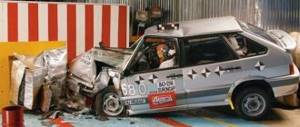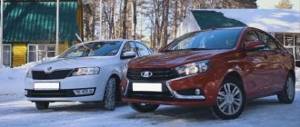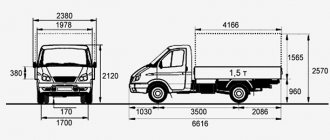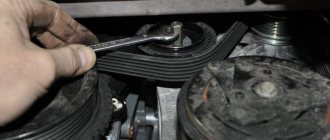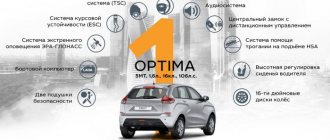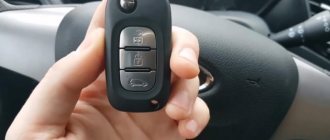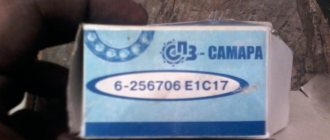Features of Lada Vesta security systems
The car is built on a new platform developed by AvtoVAZ, called Lada B, which has a lifespan of at least 15 years. In expensive versions, Vesta will be equipped with four airbags, and in medium or budget versions, two or one. Among the active safety systems, the car includes a new generation ABS+ESP Bosch system, and the luxury version will have a rear view camera located in the trunk lid.
A design feature of Vesta is that the engine and steering rack are mounted to the subframe, which makes the body more rigid and the response to steering movements more refined, which will be noticeable in vibration comfort and better handling. Mandatory options include the Era-GLONASS emergency response system installed on the car, which in the event of an accident automatically sends a signal to the rescue service or monitors the stolen car.
Where is the side airbag located on the West?
For the first time, AvtoVAZ equipped Vesta with such a passive safety element. however, not every driver will show where the side airbag is located in the car.
The location of the location is indicated by AIRBAG labels. Fabric inflatable bags are located in the side parts of the seats: on the driver’s left hand, on the front passenger’s right.
Where are the front airbags located? Photo source: https://lada-vesta.info/226-podushki-bezopasnosti-v-avtomobilyah-lada-vesta.html
Owners of the “Lux” and “Exclusive” modifications (where side air guards are installed) must observe the following precautions:
- do not use covers for the front row of seats or wear only special products;
- do not clutter the space between the sides of the seats and the door trim;
- do not hang canes, umbrellas, or other objects on the handrails;
- Do not hold children or pets.
The driver must protect the car from accidental impacts on the central pillar while the engine is running. If the device “fires,” it cannot be repaired: you will have to change the control unit, inflatable bags, and belts along with the pretensioning module.
Lada Vesta crash test results
For the first time, an independent crash test of Vesta was carried out at the NAMI car testing center, located at the Dmitrovsky training ground, by order of Autoreview. Passive safety was assessed according to the independent Russian rating program compiled by Autoreview - ARCAP. For this purpose, a sedan of the “Comfort” configuration was chosen, which has two airbags.
The car was accelerated to 64 km/h. and is directed into the ceiling with a deformable barrier at 40% on the driver's side. After the collision, both airbags deployed. The head prints of the mannequins showed that they were taken at the "design location". Inspection of the damage after the collision showed a slight displacement of the front driver's pillar (the door opening was reduced by only 4 mm).
This indicates a well-executed protection of the interior “cage” from deformation. A slight displacement of the steering wheel and pedals was noted, but the windshield was not damaged, which was observed for the first time in such tests. After the collision, the ERA-GLONASS system sent an automatic message about the accident, determining its exact location, and after 10 seconds. I received a response request from the call center.
As a result of the test, it was found that in the event of an accident, the driver and front passenger's chest is more vulnerable, and after an oblique frontal collision, the leg above the knee may be damaged, while the legs and feet will not be damaged. The mannequins' heads experienced a maximum load of 53 g (safe up to 73 g). The load on the shins, knees and neck was relatively low. Only the driver's ribs were damaged - they were dented by 28 mm.
According to the summed up results, the car turned out to be safer than such popular models as Hyundai Solaris, Ford Focus, and was only slightly inferior to the Volkswagen Polo sedan. At the same time, Vesta scored 14.1 points, corresponding to the maximum number of stars according to the ARCAP classification. Previously, the safety of Focus was rated at 11.6 points, and Solaris at 8.5 points, Polo scored 14.3 points.
AvtoVAZ specialists present at the test were not surprised by the result and explained that during 2014 and 2020. About 150 virtual and over 30 real crash tests of this car were performed. As the president of the concern, Bo Andersen, noted, the received maximum rating of 4 stars indicates the increased level of technology of the Russian auto giant, which has created a car that meets all global safety standards.
Insurance test
This type of crash test, also called the Danner test or the bumper test, consists of a car colliding with its front side at a speed of 15 km/h with a non-deformable barrier that imitates the bumper of a standing car.
The AutoReview publication conducted an insurance test for the Lada Vesta in the passive safety laboratory at the Dmitrovsky test site to demonstrate the consequences of a typical accident in urban conditions involving a sedan. A Vesta at a set speed of 15 km/h with ballast weighing 50 kg in the trunk was collided with a stationary obstacle simulating a bumper, blocking the front of the sedan on the left by 40% and located at an angle of 80 degrees to the axis of the car.
The purpose of this test is to show how serious it will be for Vesta and how expensive it will be for the car owner to repair after a minor accident in the city, when the car “catch up” with the car in front or run into a standing one - the safety of the car also has an economic component. Based on the results of the bumper test, we compiled costing of repairs in official and regular auto repair shops.
Damage during an insurance crash test
After the impact, the driver's door opened absolutely freely, the hood was opened with little effort, but without improvised means, no leaks of working fluids were observed.
The bumper is destroyed, and its restoration is impractical - only replacement. The broken left headlight moved back and slightly crushed the front part of the fender, and the upper front cross member under the hood also moved towards the engine. Oddly enough, the radiator grille was preserved intact, except for one latch, and its upper mount was torn out of place. At the same time, the radiator itself is not damaged, only the honeycombs are slightly crumpled, which indicates that its brackets are designed to be torn while preserving the unit itself.
The transverse front beam is deformed, the left supporting part is crushed almost to the maximum, but the geometry of the side members is not broken, which also indicates that the Lada Vesta uses the method of shock-absorbing deformations incorporated into the design.
The beam has no welded joints with the spar, so replacing it will not weaken the rigidity of the elements due to heating during cutting and welding.
Repair costs
Repair of the described damage to the Lada Vesta from an official dealer will cost the following amount:
- repair and restoration work - 40 thousand rubles;
- spare parts and components – 70 thousand rubles.
Total – 110 thousand rubles. with a 1 month wait for parts to arrive.
At a regular car service center, the cost of restoring Vesta will be:
- work - the same 40 thousand rubles;
- spare parts – 20 thousand rubles.
Total – 60 thousand rubles.
The fact is that the official dealer planned to restore only the front left fender, the remaining damaged parts were to be replaced with new ones. And during repairs at a regular service center, you would only have to buy a new headlight, crossbar and chrome bumper trim. All other parts were planned for restoration.
If we analyze the cost of similar repairs of foreign car brands in relation to the cost of a new car, we will get the following picture.
The conclusion from the comparison of ratios is that repairing Lada Vesta at universal service stations after the expiration of the warranty period is more attractive compared to the situation with restoring foreign cars.
What is a crash test
After development, cars of all types and classes are checked for safety through crash testing. To do this, various obstacles are placed on the road intended for testing to simulate traffic accidents that cause both minor and major damage. The main objective of the test is to determine the consequences of the accident and how they affect the driver and passengers sitting in the car.
To do this, special dummies are placed inside the car, equipped with sensors that record the impact force and local damage. Modern crash tests are carried out in accordance with European standards, the result of which is the assignment of a certain number of points. For more critical damage, the vehicle's safety system receives fewer points.
When testing new vehicles, the tests simulate frontal and side impacts, as well as rear-end collisions with another vehicle moving behind it. Crash tests vary in cost: frontal is the cheapest and simplest, it is always carried out. To do this, the test sample is accelerated and directed at a certain speed into a concrete block.
It is not always possible to simulate side or rear-end collisions due to lack of equipment. Such tests are carried out much less frequently, although accidents with this type of damage occur more often than head-on collisions. Currently, many companies are developing equipment for high-quality performance of various crash tests.
How many airbags are there in Vesta?
Seat belts have been used in cars since the middle of the last century. Pillows are a relatively new product, but modern cars are no longer produced without them. In tandem, two devices save 75% of those involved in road accidents from injury.
Airbags. Photo source: https://airbag-servis.com.ua/blog/zashhita-podushkami-bezopasnosti-airbag
How many airbags are available on the Vesta depends on the modification:
- Classic and Comfort - 2 pieces each: driver and front passenger (airbag with switch-off function).
- Luxs and Exclusive - 4 pieces each: also a driver, a front passenger (airbag with shutdown), plus 2 side ones.
In a head-on collision, the car stops, and the crew “flies” forward by inertia. The airbags open, inflate, and absorb the impact energy in a split second. People do not collide with the steering wheel, windshield, pillars, or instrument panel and, as a result, receive fewer injuries.
Frontal kick
Technical information before the test
We will break down a car with the maximum configuration, costing almost 800 thousand rubles. Its safety cage, if you can call the cabin that way, is identical to the regular Vesta. Therefore, you shouldn’t expect a miracle from her in a frontal attack.
I wonder how different the crash test results of the Vesta Cross will be from the sedan? It is worth remembering that in previous tests, the sedan received 4 stars and 14.1 points out of 16 possible according to Autoreview. It takes 3rd place in the safety rating of people's cars, behind the Polo Sedan and Hyundai Solaris.
But over the course of several years, certain changes have occurred in the design of Vesta, which should improve the passive safety in the Cross version:
- An amplifier is installed in the arch of the windshield, which extends to the middle of the doorway.
- The sills, which in the sedan collapsed upon impact, have been strengthened.
- 4 airbags. But those installed in the backs of the front seats are unlikely to play a decisive role in a frontal impact.
Increased ground clearance, larger rims and the weight of the car, which is 148 kg more than the Vesta sedan, can significantly affect the crash test results. We are watching carefully and waiting for the results.
Video of the Lada Vesta SV Cross crash test - frontal impact:
results
In appearance, the SV Cross withstood the crash test well. The windshield pillar is in place and not wrinkled. The left spar worked better than on the sedan - it folded like an accordion, taking away a significant part of the frontal impact. The large cast disk broke and became deformed, absorbing some of the energy.
Click on the picture to enlarge it
The threshold on the driver's side is quite wrinkled . Although VAZ engineers specially strengthened it in 2020, this will take away several points from the Cross based on crash test results. Having removed the floor mats and soundproofing mats, we discovered that the floor under the driver’s seat had “heaved up” and torn. In places of spot welding, the metal is connected reliably, but even there it was torn.
In the language of experts, this is called destruction of the driver’s legroom, which was not the case with X-Ray. As a result of deformation and lifting of the floor, additional loads were created on the mannequin's lower leg.
The driver's door opened almost without problems. At first glance, everything in the cabin looks decent. The driver and passenger survived. Let's see what damage they received. The head and neck were not injured; they were protected by airbags, which they clearly hit. The chest was not injured, the seat belt held it with the necessary force, the ribs were compressed less than in the Vesta sedan. The steering wheel has moved 30 mm away from the driver - just like in modern cars. The left knee did not touch the panel, the right knee was slightly injured on the plastic parts of the interior. The mannequin's feet are intact. Although the pedal assembly moved into the cabin during a frontal impact, the amount of its movement was not significant, in comparison with the UAZ Patriot, where the pedals “turned” the driver’s feet in the other direction.
Passive protection of Lada Vesta
A major achievement of the leader of the domestic automobile industry is reaching a new level of vehicle safety. Depending on the configuration, models will be equipped with airbags - at least two, and in expensive versions four. In principle, such a solution has already been implemented in luxury Priora models, but the safety of the Lada Vesta will be higher. Structurally, the car is designed for a 4-star crash test according to the Euro NCAP standard. The best representatives of the class have similar characteristics.
In just a year, it was possible not only to establish the operation of the conveyor and additional production areas, but also to conduct full tests of the machine in all respects. Hundreds, if not thousands of virtual collisions were generated using the latest computer technologies, but the need to test the accuracy and reliability of the assembly in practice has not been canceled. It’s not even about the number of crash test stars; it was important to show the result to professionals and ordinary car enthusiasts. Now everyone can watch the video of Vesta taking a frontal blow. The tests carried out in 2020 will continue in 2016, based on feedback and possible deficiencies identified.
How are the tests carried out?
According to ARCAP, the crash test is a frontal collision of a car at a speed of 64 km/h with a deformable barrier that simulates the front of a passenger car using aluminum particles. Statistics show that direct collisions are rare, so testing involves hitting the car with an obstacle from the front. Where is the driver? The established overlap size is 40%. This is the ability to simulate an offset, head-on collision between two vehicles having almost the same mass.
Total speed – 110 km/h. 2 mannequins are seated in the cabin, and with the help of sensors installed on them, information about the overloads that act upon impact on such parts of the body as the head, lower leg, chest, kneecaps and hip area is recorded. They examine information on the driver and front row passenger, calculating what injuries they may receive. And with what probability? The calculation takes into account the movement of the steering wheel, the shift of the front left pillars and pedals. Such testing is possible at AVTOVAZ in the Russian Federation, as well as in the Czech Republic, thanks to the specialists of TÜV SÜD Czech
